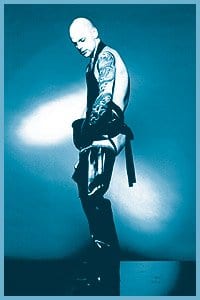“The body is as much a garment as the clothes that go over top of it.” Max Allen holds forth on morality, sex, nudity and taboo. His conversation, however, suggestive as it is, is taking place in a museum.
But for Allen, co-founder of the Textile Museum Of Canada, raising hackles in staid institutions is the norm. As well as curating, Allen also works as a producer at the CBC and is a longtime opponent of censorship. He has pushed many buttons both literally and figuratively over the years.
But Allen’s subject du jour is Moral Fibre: Dress Codes From Purity To Wickedness, on display at the Textile Museum until Jan 19. Curated by Allen, the exhibit explores the ways in which textiles and clothing convey messages about good, evil, guilt and innocence.
Drawing on a variety of sources, from Buddhist priests and Victorian brides to trends in contemporary clothing, Allen’s exhibit attempts to inspire and provoke. Allen assures that signs will be mounted warning visitors of the strong content. A leather body bag lying prone and mute across a platform at the start of the exhibit is cited as one such shocker.
Moral Fibre is divided into a number of sections, with varying results. One very effective category is “Tatters,” where new and expensive cloth is purposefully ruined to subvert its value. To illustrate his point, Allen has displayed the kesas of a Buddhist priest. This garment has been assembled from the remnants of an expensive bolt of gorgeous brocade cut into pieces for the appearance of humility.
Allen sees this trend as a manifestation of wealth guilt. He also finds it in the mass-produced, purposefully distressed denim fashions now popular. One such garment on display is a bustier made to look like it has been hobbled together from an old pair of jeans. Allen says he found this example among a row of identical bustiers, which all had identical wear ‘n’ tear. Perhaps in our politically correct times, fashionistas with a social conscience are responding to pressure to tone down their obvious consumerism.
Other sections are less successful. “Black And White Mor(t)ality” explores the symbolism of black and white and their shifting significance in society: Didn’t the colour white mean virginal until Calvin Klein’s obsession with models in undershorts made it sexual? Isn’t black the colour of death and evil, yet it is worn by the good Christian clergy?
This display, made up for the most part of a Marky Mark poster and an essay tacked to the wall, does not go far enough in drawing one into the tactile world of textiles, though included are several lovely off-white wedding gowns.
The most teasing category in Moral Fibre is the “Second Skins” exhibits. These displays immediately bring sexual escapades to mind, either your own or those of others. Allen explains: “Tight shiny non-woven-ness will always hold its own… leather, latex, rubber has the same impact universally. And I think it’s because it’s very much like skin, its meaning is pretty well understood. But looseness or frilliness, colour, cut or length, their meaning comes and goes.”
As Allen finishes the tour, in a shady nook at the end of the exhibit, he is standing in front of a diminutive mannequin, draped in a cotton shroud, a pretty shade of blue, with beautiful needlework surrounding the netting covering the eyes. It is a burqa.
Allen points out that he had considered putting it next to the leather body bag at the front of the museum. If connections like that had been made, Moral Fibre would have produced the desired shock.
Moral Fibre: Dress Codes From Purity To Wickedness.
$8. Till Jan 19.
The Textile Museum Of Canada.
55 Centre Ave.
(416) 599-5321.

 Why you can trust Xtra
Why you can trust Xtra


